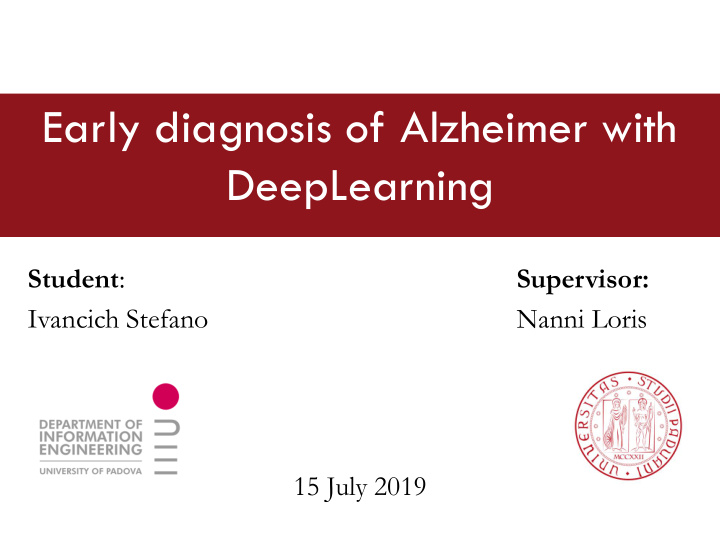



Early diagnosis of Alzheimer with DeepLearning Student : Supervisor: Ivancich Stefano Nanni Loris 15 July 2019
The Problem • Alzheimer’s disease (AD) is a neurological pathology that affects more than 47 million people worldwide, being the first cause of neurodegenerative dementia. • Its prevalence is estimated to be around 5% after 65 years old and a staggering 30% for the more than 85 years old in developed countries. • From now to 2050 it is estimated that 640 Million people in the world will be diagnosed with AD. • The most common symptoms are problems in remembering, reasoning, orienting . • It has become a major social and economic issue and its effects are devastating not only for the diseased but also for their families . • For effective treatments to be administered that are capable to slow down the progression of the disease, an early and definite diagnosis is necessary. Ivancich Stefano 1 15 July 2019
The Old Solution Diagnosis of AD is still primarily based on: • Mental status testing • Neuropsychological tests • Interviews with friends and family • Measurement of cerebrospinal fluid (CSF), invasive • Rachisynthesis , which is painful and dangerous for a patient Early diagnosis requires an investigation of the pre-dementia, called Mild Cognitive Impairment (MCI) , that is a condition in which an individual’s thinking ability shows some mild changes. This stage involves the challenging question of predicting whether MCI will (MCIc) or will not (MCInc) convert to AD. Ivancich Stefano 2 15 July 2019
Our New Solution Our solution is based on the classification of Magnetic Resonance scans (MRI) with DeepLearning Algorithms. Not Invasive, not dangerous Particularly our approach consist in solving three binary classification problems : • CN vs AD • CN vs MCIc • MCInc vs MCIc Ivancich Stefano 3 15 July 2019
Why DeepLearning? Nowadays, deep learning is becoming a leading machine-learning tool in the general imaging and computer vision domains. In particular, convolutional neural networks (CNNs) have presented outstanding effectiveness on medical image computing problems . Some examples: • Prof. Greenspan, Tel Aviv University, Israel: employed CNN to improve three existing CAD systems for the recognition of colonic polyps on CT colonography, sclerotic spine metastases on body CT and enlarged lymph nodes on body CT. • Prof. Qi Dou, Imperial College London: used 3D CNN and weighted MRI scans to detect cerebral microbleeds. They address developed predictions with their 3D CNN compared to various classical and 2D CNN approaches. • Prof. Rajpoot, University of Warwick, UK: employed CNNs to detect nuclei in histopathological images. • Prof. Anthimopoulos, University of Bern, Switzerland: employed CNNs to detect patterns of interstitial lung diseases from 2D patches of chest CT scans. Their results show that CNNs can outperform existing methods that use hand-crafted features. Ivancich Stefano 15 July 2019 4
Image Extraction MRI are 3D so to make them 2D we used the following image extraction operation: for a given voxel point, three patches of MRI 32x32 are extracted from the three planes, concatenated into a three-channel picture and resized in order to match the input size of the neural network. Ivancich Stefano 5 15 July 2019
Example Ivancich Stefano 6 15 July 2019
Production Architecture Ivancich Stefano 7 15 July 2019
Training Architecture • Extract 100 pictures from each MRI • Perform some data augmentation • Fed them into AlexNet Ivancich Stefano 8 15 July 2019
Architecture A key challenge in applying CNNs is that sufficient training data are not always available in medical images. To avoid Over/Under-fitting: • Data Augmentation: In case of medical images this often comes down to mirror flipping , small-magnitude translations, weak Gaussian blurring, brightness augmentation and shadow augmentation . • TransferLearning from AlexNet: training CNN from scratch is usually challenging owing to the limited amount of labeled medical data. A promising alternative is to fine-tune the weights of a network that was trained using a large set of labeled natural images. o Prof. Tajbakhsh, Illinois Institute of Technology: considered several medical imaging applications and investigated how the performance of CNNs trained from scratch compared with the pre-trained CNNs. Their experiments demonstrated that pretrained CNNs performed better than CNN trained from scratch. Ivancich Stefano 9 15 July 2019
Performances Due to the lack of memory (RAM) and computational power given to us, as we were undergraduate students: Instead of converting each MRI in 100 pictures, we have extracted only 8 pictures for each MRI, Trained on 3 folds instead of 20, haven’t performed any data augmentation. However, our supervisor will execute more exhaustive tests . CN vs AD: CN vs MCIc: MCInc vs MCIc: 10 Ivancich Stefano 15 July 2019
Conclusions Conclusions: • The tests showed that our model was very good at classify CN vs AD , that is an extraordinary results, because today to recognize if a person has Alzheimer different invasive medical tests must be done. With our model we need just a Magnetic Resonance. • Unfortunately CN vs MCIc and MCInc vs MCIc problems doesn’t reach good results, we think most of the problem is due to the lack of computational power. Future Work: • Try different hyper-parameters during training • Change the structure of the network using: • pretrained VGG-19 or Inception v4 • 3D-Convolution Ivancich Stefano 15 July 2019 11
Thank You Thanks for your attention! Any questions? Ivancich Stefano 15 July 2019 12
Recommend
More recommend